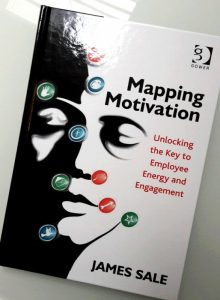- Bringing Art to Life: Shycheeks Gifs
- The death of the skinny jeans: wide leg trend comes back
- Assassin’s Creed film: an Epic Visual Treat
- Quick feed: Japanese company creates clone dolls that reside in the “uncanny valley”
- The beauty of street photography: Manu Fernández
- I wish airports were that much fun! ‘Vamos Cuba’ at Sadler’s Wells
- Upcycled Baby Bandanas: my latest project
- Designing “Tideway”: a photography book on River Thames
- A celebration of River Thames: “Tideway” by Matthew Joseph
- Wearable Art for the modern women: mefaldas tú
Mapping Motivation – A book away from your career success
 If you follow our interview stories regularly, you might have read previous interviews with friend and motivational speaker James Sale. He played a key role in my own professional development, his advice is high valuable to me. After years helping businesses and individuals to achieve their goals, James has decided to put together a book full of his unquestionable knowledge on motivational coaching.
If you follow our interview stories regularly, you might have read previous interviews with friend and motivational speaker James Sale. He played a key role in my own professional development, his advice is high valuable to me. After years helping businesses and individuals to achieve their goals, James has decided to put together a book full of his unquestionable knowledge on motivational coaching.
Mapping Motivation is not a self-help book. It is a self-discovery book, a must-have book for anyone interested in career development. Either if you are employer, an employee or a business entrepreneur, this book is packed with very useful advice and tips on how to get the most of your/your employees’ potential, with a common goal of professional success and personal reward. Using an interesting and effective personality-profiling tool, Sale’s motivational maps are based on the idea that each individual is motivated at work by different factors, and the self-discovery of those motivational factors and the application of those on the workplace, can lead to use of one’s maximum potential. In a bigger scale, the use of maps by employers on company’s new joiners, would provide a full understanding on each employee’s goals, strengths and motivations at the workplace, information of great help for business owners as to improve internal relationships and, subsequently, to reach any company’s goals.
Sale’s language is clear and his narrative is dynamic and . His expertise on the field shows with the amount of practical examples and the case studies at the end of the book.
I asked him a few questions about his own personal journey when writing this book.
The Creative Post: After years of experience as motivational coach and speaker you publish this book. Why now?
James Sale: To write a book is to become an author, and to be an author is to be an authority; you can see the words author and authority have the same root. Thus it is that although I had been an authority on motivation and performance for quite some years, I realised that as a business we were not benefiting enough from this fact because – in simple terms – there was no book out there that proved my credentials. The key thing for all your readers to understand if they wish to become authorities – or gurus – in any given field, whether it is consultancy, graphic design, IT, teaching, or anything else – perhaps the best method of all to establish that fact is by bringing out the book on the topic of which you know so much. Put another way, then: my book, Mapping Motivation, was inevitable; I had to write it to prove I was a guru of motivation!
The key problem that the corporates have is that they have advanced systems and processes, which is good in some respects, but in others, especially relating to their employees, it means they adopt a ‘one-size-fits-all’ approach.
 T.C.P.: How your book can help the regular employee to feel happier and motivated at her/his current role?
T.C.P.: How your book can help the regular employee to feel happier and motivated at her/his current role?
J.S.: My book will any employee, any person in fact, feel happier and more motivated at work in the same way that a fitness book would help you get physically into shape. It’s no good just reading a fitness book, of course: you have to do the exercises too. But if you follow the instructions and do the exercises one good book can help turn your fitness around. And so it is with motivation. The difference here is that physical fitness and its lack is far more visible to the human eye than motivation. Most people do not realise that they can directly affect and impact their motivators and part of the reason for this is because they don’t actually know what motivates them! This seems bizarre, but it is true. The reason for it is that people ‘think’ they know their motivators, but motivators are really feelings, and we can easily mislead ourselves into thinking we know our motivators. However, Mapping Motivation is very strong in the first instance in helping anyone identify exactly what their motivators are just on their own; and if that weren’t enough, everyone who has the book will find that special little code tucked away in a corner from which they can claim their own free Motivational Map and find out for certain for motivates them. So, yes, this book provides a comprehensive blueprint on how to get yourself motivated.
T.C.P.: What is you take on the phenomenon of individuals moving jobs every few months? Boredom, lack of recognition, failure to get promoted and individual ambitions are frequent factors, which can/are discussed during appraisal processes. What can be done better by employers on their employees’ appraisal rounds?
J.S.: My ultimate take on this is threefold: first, there are people who for perfectly sound and personal reasons need to avoid a total commitment at some stage of their life, and so moving jobs and accepting interim posts is ideal for them, and can easily satisfy their motivators. And this is good. Second, there are people who are low in self-esteem, self-confidence, who cannot form and sustain relationships, and who fear being ‘discovered’ for who they really are if they stay; these people will tend to be rootless, dissipated, and problematic. This is not good. Finally, there are the people who most interest me. These people are those who want stability, who want to make a contribution, who want to develop deeper levels of expertise, but unfortunately keep arriving in posts in which none of their top three motivators are being met, and often because of bad management or leadership. Now these people can seriously be helped through Mapping Motivation, my book. Why? Because usually they are unaware of the issues of their motivators and what they would need to do to address them – specifically, becoming far more picky, choosy, in job selection at the outset. Regarding Appraisals – wow – read Mapping Motivation for our exclusive take on this. But in essence, Appraisal fail precisely because they are predominantly in ‘think’ mode; what Motivational Maps enables is a discussion with the manager which shifts into ‘feel’ mode right at the start. This simple manoeuvre makes a world of difference and changes the whole nature of the relationship. Indeed, we are seriously helping managers manage more effectively as well at the same time as empowering the employee.
Mapping Motivation is helping anyone identify what their motivators are, and everyone who has the book will find that special little code tucked away in a corner from which they can claim their own free Motivational Map and find out for certain for motivates them.
T.C.P.: How can the big organisations retain talented employees with a big sense of individuality without compromising the company’s common goals? This is a problem we often see in big corporations.
J.S.: The key problem that the corporates have is that they have advanced systems and processes, which is good in some respects, but in others, especially relating to their employees, it means they adopt a ‘one-size-fits-all’ approach. They are always assuming they know what people want, even though the most senior people do not know what they personally want! Let’s remember that there are always two parallel sets of goals: the organisational goals AND the personal goals. So to be truly effective, any organisation that employees people, must seek to create an alignment, for without it employees will leave: that’s the imperative of not having your motivators met by the organisation that is supposed to nurture you. Thus, in brief, the single most important thing an organisation can do to remedy this problem is not to do another ‘employee survey’, which is another ‘think’ tool, which means staff can settle scores, flag up agendas, game play and so on – in other words, indulge in all the maliciousness of thinking! Instead, they need to survey their employees using Motivational Map so that they find out what they want – not what they think – but what they want. This is profoundly different and profoundly transformative once its implications have been grasped. Give people what they want and you will find it is much easier to retain them: why go anywhere else, my motivators are being met.
I had been an authority on motivation and performance for quite some years, I realised that as a business we were not benefiting enough from this fact because – in simple terms – there was no book out there that proved my credentials.
T.C.P.: Please explain what motivational maps are and how they can help individuals to define/redefine a career path
J.S.: Motivational Maps are a self-perception inventory, which means an ipsative diagnostic tool, which means a questionnaire which measures you against yourself to determine what motivates you and how motivated you are at any given moment. It is not a personality or psychometric tool: nobody goes to work on a Monday morning because of their personality! They go because of their motivators, which is why we say that motivation and performance are intimately connected. Everybody has nine motivators in their inner psyche, but we all have them in a different rank order and in differing levels of intensity. Thus, there are easily well over 5 million possible combinations of Maps – it’s as diverse as that, and more accurately reflects what is going on in people rather than, say, ’16 types’. The key thing to know is that for most people it is the top three motivators that determine what they want from the work environment. Some of these motivators re-inforce each other, and some conflict – a reason why some people are highly indecisive: their internal motivators clash! Thus any career path has dominant motivators that are almost intrinsic to it. For example, a typically commissioned based sales person will be motivated, often, by freedom, by money and by expertise; they will not usually be motivated by security, belonging, or control. Or take an accountant type: we have found that they are typically motivated by security, by making a difference, and by expertise. The list isn’t exclusive and it is not stereotypical, exceptions do occur, but in thinking about the kind of job and role you are going to do, the Maps help you position yourself so that the motivators are abundantly built into the position. I had a situation some while ago with a lawyer who was unhappy working in a large corporate practice; freedom was her number one motivator. But in a large practice she was at the mercy of the system, specifically charging her time out every 10 minutes to clients; she had not discretionary time at all, which is the opposite of freedom and autonomy. I suggested to her she go work as a lawyer for a small, boutique kind of legal firm where the system wasn’t so oppressive and she would be enabled to do more of what she wanted for the company. Result? Perfect – a much happier lawyer; within six months she was promoted.
You can purchase James Sale’s book Mapping Motivation Amazon here: http://www.amazon.co.uk/Mapping-Motivation-Unlocking-Employee-Engagement/dp/147245927X/ref=cm_sw_em_r_dpop_cF-9vb0QSWZW3_lm









You must be logged in to post a comment Login